BSS017-2 Sustainable Business Management: Patagonia's Approach
VerifiedAdded on 2023/06/18
|7
|1778
|193
Report
AI Summary
This report examines Patagonia's approach to sustainable business management, focusing on the challenges and opportunities within the context of economic, social, and environmental factors. It delves into Patagonia's background, highlighting its commitment to sustainability through energy conservation, recycling, and waste reduction. The report analyzes key sustainable challenges faced by Patagonia, utilizing the triple bottom line theory to assess environmental, social, and economic impacts. Furthermore, it explores the application of the waste hierarchy framework—reduce, reuse, recycle, recover, and landfilling—in delivering sustainability within the organization. The analysis considers factors such as increasing population, changing consumer preferences, and inflationary pressures, and concludes by emphasizing the importance of sustainability for society and the environment, underscoring Patagonia's efforts to minimize waste and promote environmental responsibility. Desklib provides a platform to access similar solved assignments and past papers.
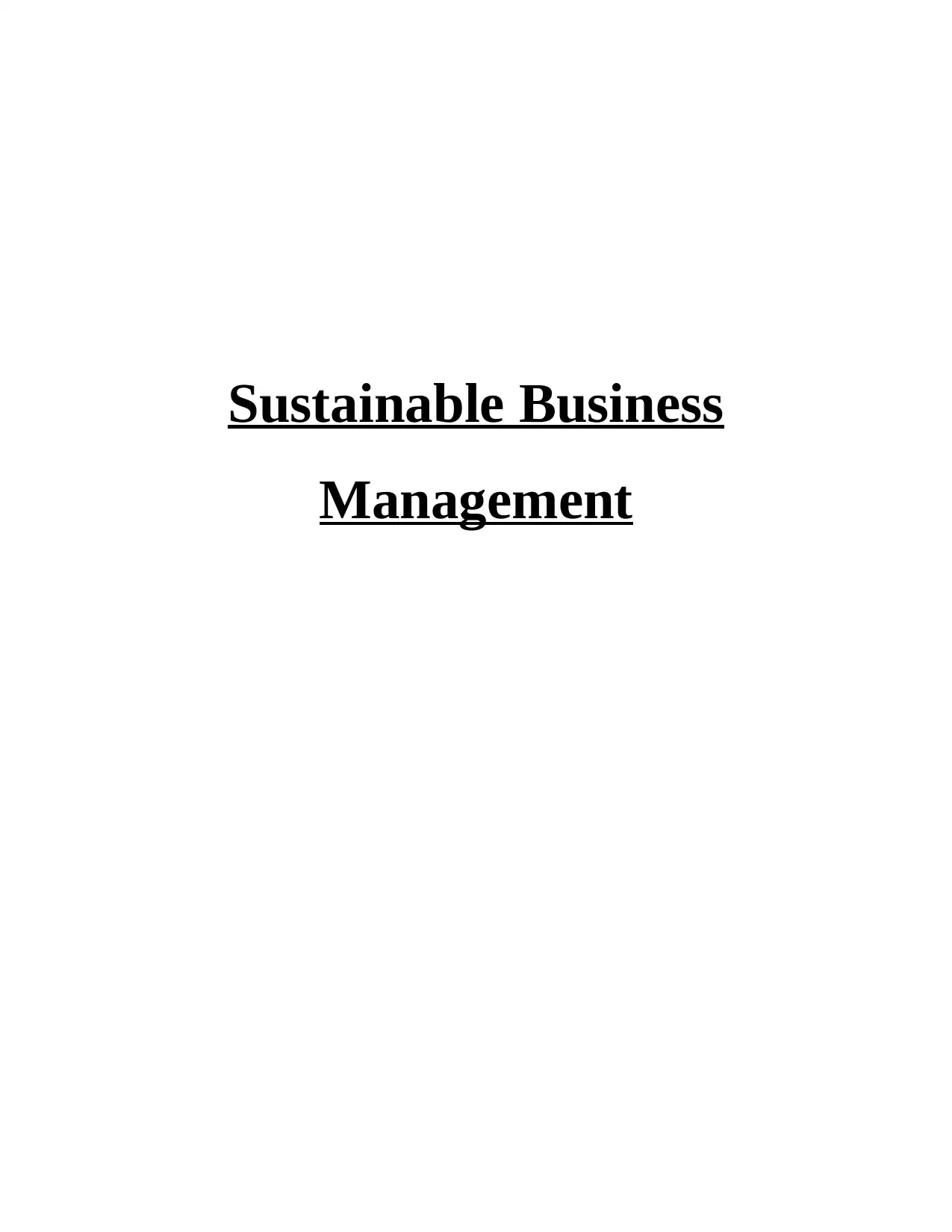
Sustainable Business
Management
Management
Paraphrase This Document
Need a fresh take? Get an instant paraphrase of this document with our AI Paraphraser
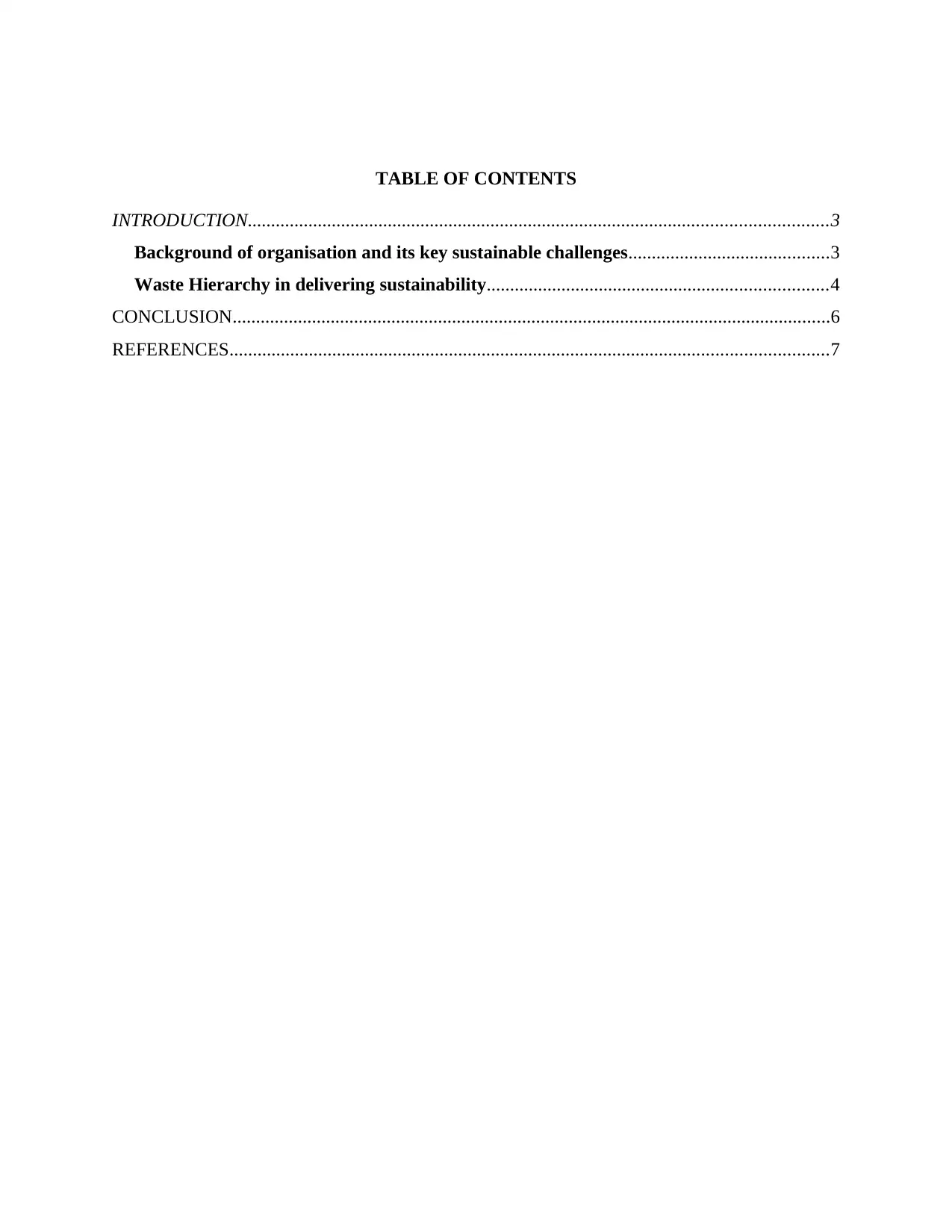
TABLE OF CONTENTS
INTRODUCTION............................................................................................................................3
Background of organisation and its key sustainable challenges...........................................3
Waste Hierarchy in delivering sustainability.........................................................................4
CONCLUSION................................................................................................................................6
REFERENCES................................................................................................................................7
INTRODUCTION............................................................................................................................3
Background of organisation and its key sustainable challenges...........................................3
Waste Hierarchy in delivering sustainability.........................................................................4
CONCLUSION................................................................................................................................6
REFERENCES................................................................................................................................7
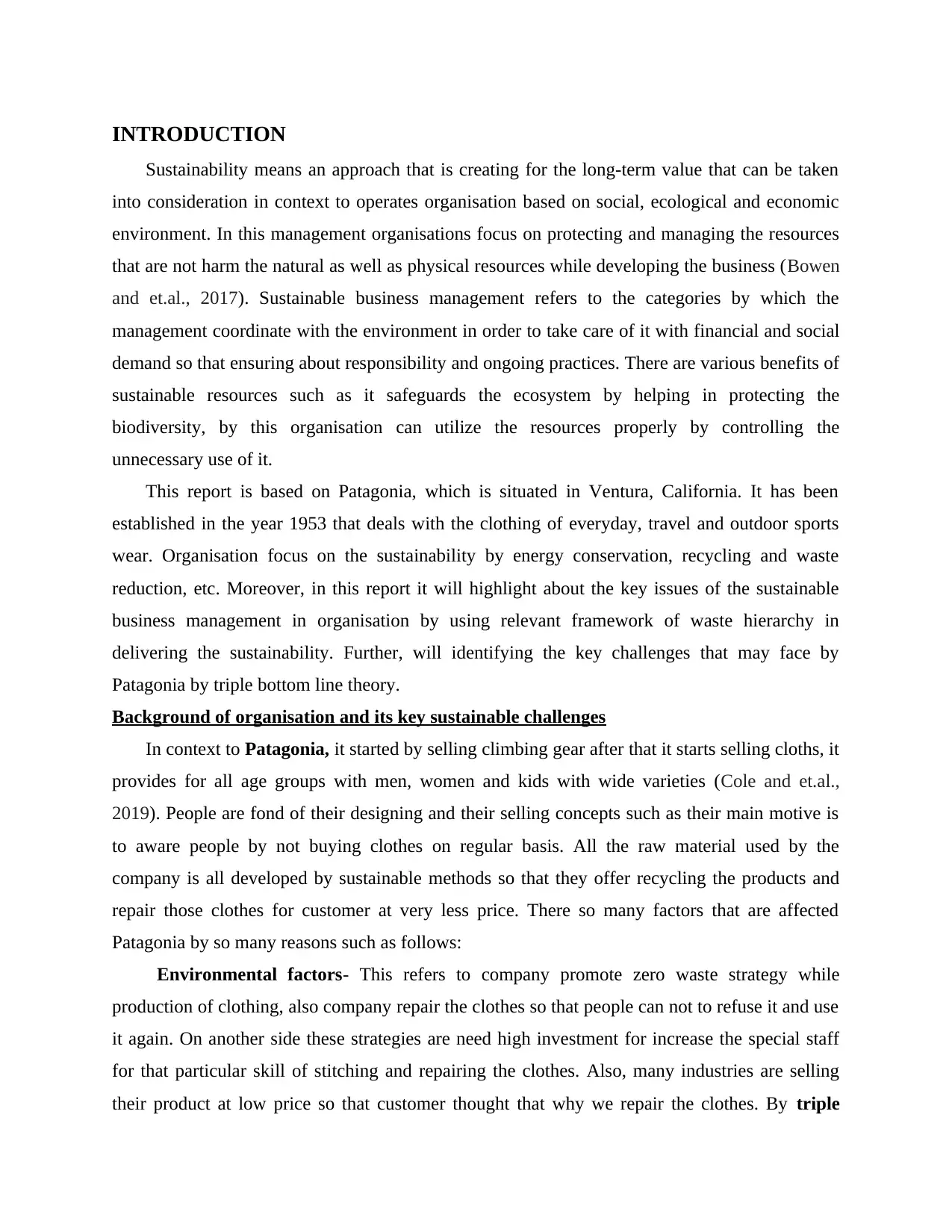
INTRODUCTION
Sustainability means an approach that is creating for the long-term value that can be taken
into consideration in context to operates organisation based on social, ecological and economic
environment. In this management organisations focus on protecting and managing the resources
that are not harm the natural as well as physical resources while developing the business (Bowen
and et.al., 2017). Sustainable business management refers to the categories by which the
management coordinate with the environment in order to take care of it with financial and social
demand so that ensuring about responsibility and ongoing practices. There are various benefits of
sustainable resources such as it safeguards the ecosystem by helping in protecting the
biodiversity, by this organisation can utilize the resources properly by controlling the
unnecessary use of it.
This report is based on Patagonia, which is situated in Ventura, California. It has been
established in the year 1953 that deals with the clothing of everyday, travel and outdoor sports
wear. Organisation focus on the sustainability by energy conservation, recycling and waste
reduction, etc. Moreover, in this report it will highlight about the key issues of the sustainable
business management in organisation by using relevant framework of waste hierarchy in
delivering the sustainability. Further, will identifying the key challenges that may face by
Patagonia by triple bottom line theory.
Background of organisation and its key sustainable challenges
In context to Patagonia, it started by selling climbing gear after that it starts selling cloths, it
provides for all age groups with men, women and kids with wide varieties (Cole and et.al.,
2019). People are fond of their designing and their selling concepts such as their main motive is
to aware people by not buying clothes on regular basis. All the raw material used by the
company is all developed by sustainable methods so that they offer recycling the products and
repair those clothes for customer at very less price. There so many factors that are affected
Patagonia by so many reasons such as follows:
Environmental factors- This refers to company promote zero waste strategy while
production of clothing, also company repair the clothes so that people can not to refuse it and use
it again. On another side these strategies are need high investment for increase the special staff
for that particular skill of stitching and repairing the clothes. Also, many industries are selling
their product at low price so that customer thought that why we repair the clothes. By triple
Sustainability means an approach that is creating for the long-term value that can be taken
into consideration in context to operates organisation based on social, ecological and economic
environment. In this management organisations focus on protecting and managing the resources
that are not harm the natural as well as physical resources while developing the business (Bowen
and et.al., 2017). Sustainable business management refers to the categories by which the
management coordinate with the environment in order to take care of it with financial and social
demand so that ensuring about responsibility and ongoing practices. There are various benefits of
sustainable resources such as it safeguards the ecosystem by helping in protecting the
biodiversity, by this organisation can utilize the resources properly by controlling the
unnecessary use of it.
This report is based on Patagonia, which is situated in Ventura, California. It has been
established in the year 1953 that deals with the clothing of everyday, travel and outdoor sports
wear. Organisation focus on the sustainability by energy conservation, recycling and waste
reduction, etc. Moreover, in this report it will highlight about the key issues of the sustainable
business management in organisation by using relevant framework of waste hierarchy in
delivering the sustainability. Further, will identifying the key challenges that may face by
Patagonia by triple bottom line theory.
Background of organisation and its key sustainable challenges
In context to Patagonia, it started by selling climbing gear after that it starts selling cloths, it
provides for all age groups with men, women and kids with wide varieties (Cole and et.al.,
2019). People are fond of their designing and their selling concepts such as their main motive is
to aware people by not buying clothes on regular basis. All the raw material used by the
company is all developed by sustainable methods so that they offer recycling the products and
repair those clothes for customer at very less price. There so many factors that are affected
Patagonia by so many reasons such as follows:
Environmental factors- This refers to company promote zero waste strategy while
production of clothing, also company repair the clothes so that people can not to refuse it and use
it again. On another side these strategies are need high investment for increase the special staff
for that particular skill of stitching and repairing the clothes. Also, many industries are selling
their product at low price so that customer thought that why we repair the clothes. By triple
⊘ This is a preview!⊘
Do you want full access?
Subscribe today to unlock all pages.

Trusted by 1+ million students worldwide
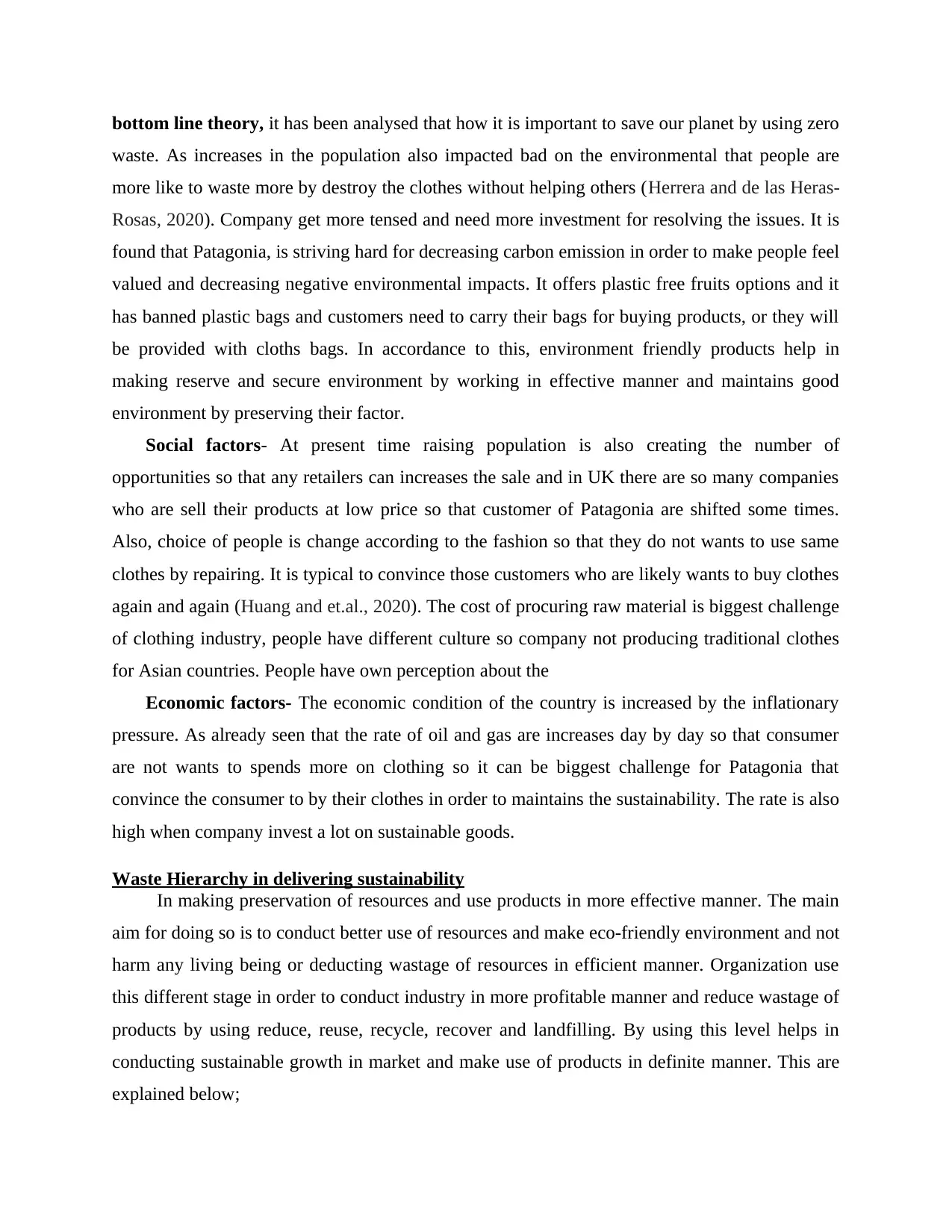
bottom line theory, it has been analysed that how it is important to save our planet by using zero
waste. As increases in the population also impacted bad on the environmental that people are
more like to waste more by destroy the clothes without helping others (Herrera and de las Heras-
Rosas, 2020). Company get more tensed and need more investment for resolving the issues. It is
found that Patagonia, is striving hard for decreasing carbon emission in order to make people feel
valued and decreasing negative environmental impacts. It offers plastic free fruits options and it
has banned plastic bags and customers need to carry their bags for buying products, or they will
be provided with cloths bags. In accordance to this, environment friendly products help in
making reserve and secure environment by working in effective manner and maintains good
environment by preserving their factor.
Social factors- At present time raising population is also creating the number of
opportunities so that any retailers can increases the sale and in UK there are so many companies
who are sell their products at low price so that customer of Patagonia are shifted some times.
Also, choice of people is change according to the fashion so that they do not wants to use same
clothes by repairing. It is typical to convince those customers who are likely wants to buy clothes
again and again (Huang and et.al., 2020). The cost of procuring raw material is biggest challenge
of clothing industry, people have different culture so company not producing traditional clothes
for Asian countries. People have own perception about the
Economic factors- The economic condition of the country is increased by the inflationary
pressure. As already seen that the rate of oil and gas are increases day by day so that consumer
are not wants to spends more on clothing so it can be biggest challenge for Patagonia that
convince the consumer to by their clothes in order to maintains the sustainability. The rate is also
high when company invest a lot on sustainable goods.
Waste Hierarchy in delivering sustainability
In making preservation of resources and use products in more effective manner. The main
aim for doing so is to conduct better use of resources and make eco-friendly environment and not
harm any living being or deducting wastage of resources in efficient manner. Organization use
this different stage in order to conduct industry in more profitable manner and reduce wastage of
products by using reduce, reuse, recycle, recover and landfilling. By using this level helps in
conducting sustainable growth in market and make use of products in definite manner. This are
explained below;
waste. As increases in the population also impacted bad on the environmental that people are
more like to waste more by destroy the clothes without helping others (Herrera and de las Heras-
Rosas, 2020). Company get more tensed and need more investment for resolving the issues. It is
found that Patagonia, is striving hard for decreasing carbon emission in order to make people feel
valued and decreasing negative environmental impacts. It offers plastic free fruits options and it
has banned plastic bags and customers need to carry their bags for buying products, or they will
be provided with cloths bags. In accordance to this, environment friendly products help in
making reserve and secure environment by working in effective manner and maintains good
environment by preserving their factor.
Social factors- At present time raising population is also creating the number of
opportunities so that any retailers can increases the sale and in UK there are so many companies
who are sell their products at low price so that customer of Patagonia are shifted some times.
Also, choice of people is change according to the fashion so that they do not wants to use same
clothes by repairing. It is typical to convince those customers who are likely wants to buy clothes
again and again (Huang and et.al., 2020). The cost of procuring raw material is biggest challenge
of clothing industry, people have different culture so company not producing traditional clothes
for Asian countries. People have own perception about the
Economic factors- The economic condition of the country is increased by the inflationary
pressure. As already seen that the rate of oil and gas are increases day by day so that consumer
are not wants to spends more on clothing so it can be biggest challenge for Patagonia that
convince the consumer to by their clothes in order to maintains the sustainability. The rate is also
high when company invest a lot on sustainable goods.
Waste Hierarchy in delivering sustainability
In making preservation of resources and use products in more effective manner. The main
aim for doing so is to conduct better use of resources and make eco-friendly environment and not
harm any living being or deducting wastage of resources in efficient manner. Organization use
this different stage in order to conduct industry in more profitable manner and reduce wastage of
products by using reduce, reuse, recycle, recover and landfilling. By using this level helps in
conducting sustainable growth in market and make use of products in definite manner. This are
explained below;
Paraphrase This Document
Need a fresh take? Get an instant paraphrase of this document with our AI Paraphraser
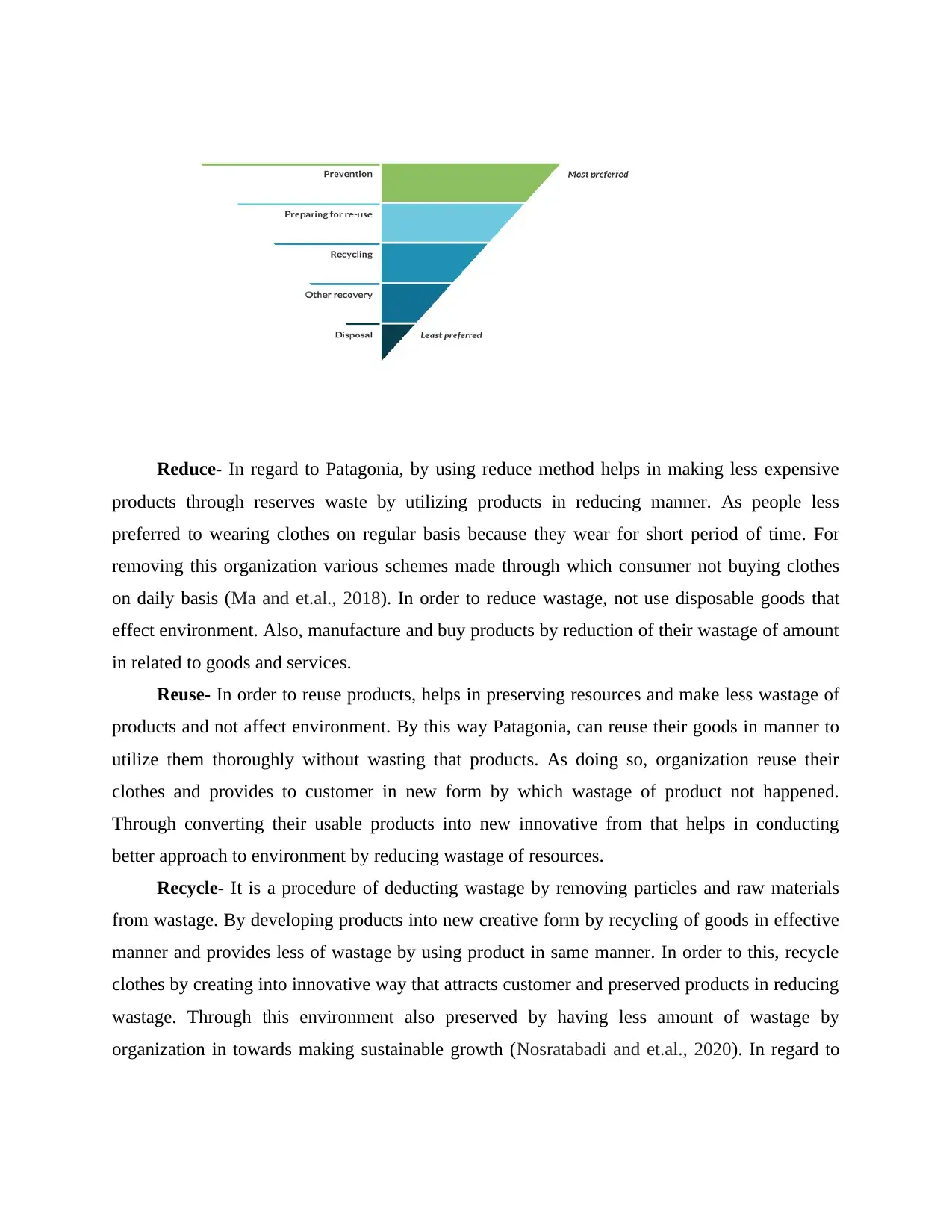
Reduce- In regard to Patagonia, by using reduce method helps in making less expensive
products through reserves waste by utilizing products in reducing manner. As people less
preferred to wearing clothes on regular basis because they wear for short period of time. For
removing this organization various schemes made through which consumer not buying clothes
on daily basis (Ma and et.al., 2018). In order to reduce wastage, not use disposable goods that
effect environment. Also, manufacture and buy products by reduction of their wastage of amount
in related to goods and services.
Reuse- In order to reuse products, helps in preserving resources and make less wastage of
products and not affect environment. By this way Patagonia, can reuse their goods in manner to
utilize them thoroughly without wasting that products. As doing so, organization reuse their
clothes and provides to customer in new form by which wastage of product not happened.
Through converting their usable products into new innovative from that helps in conducting
better approach to environment by reducing wastage of resources.
Recycle- It is a procedure of deducting wastage by removing particles and raw materials
from wastage. By developing products into new creative form by recycling of goods in effective
manner and provides less of wastage by using product in same manner. In order to this, recycle
clothes by creating into innovative way that attracts customer and preserved products in reducing
wastage. Through this environment also preserved by having less amount of wastage by
organization in towards making sustainable growth (Nosratabadi and et.al., 2020). In regard to
products through reserves waste by utilizing products in reducing manner. As people less
preferred to wearing clothes on regular basis because they wear for short period of time. For
removing this organization various schemes made through which consumer not buying clothes
on daily basis (Ma and et.al., 2018). In order to reduce wastage, not use disposable goods that
effect environment. Also, manufacture and buy products by reduction of their wastage of amount
in related to goods and services.
Reuse- In order to reuse products, helps in preserving resources and make less wastage of
products and not affect environment. By this way Patagonia, can reuse their goods in manner to
utilize them thoroughly without wasting that products. As doing so, organization reuse their
clothes and provides to customer in new form by which wastage of product not happened.
Through converting their usable products into new innovative from that helps in conducting
better approach to environment by reducing wastage of resources.
Recycle- It is a procedure of deducting wastage by removing particles and raw materials
from wastage. By developing products into new creative form by recycling of goods in effective
manner and provides less of wastage by using product in same manner. In order to this, recycle
clothes by creating into innovative way that attracts customer and preserved products in reducing
wastage. Through this environment also preserved by having less amount of wastage by
organization in towards making sustainable growth (Nosratabadi and et.al., 2020). In regard to
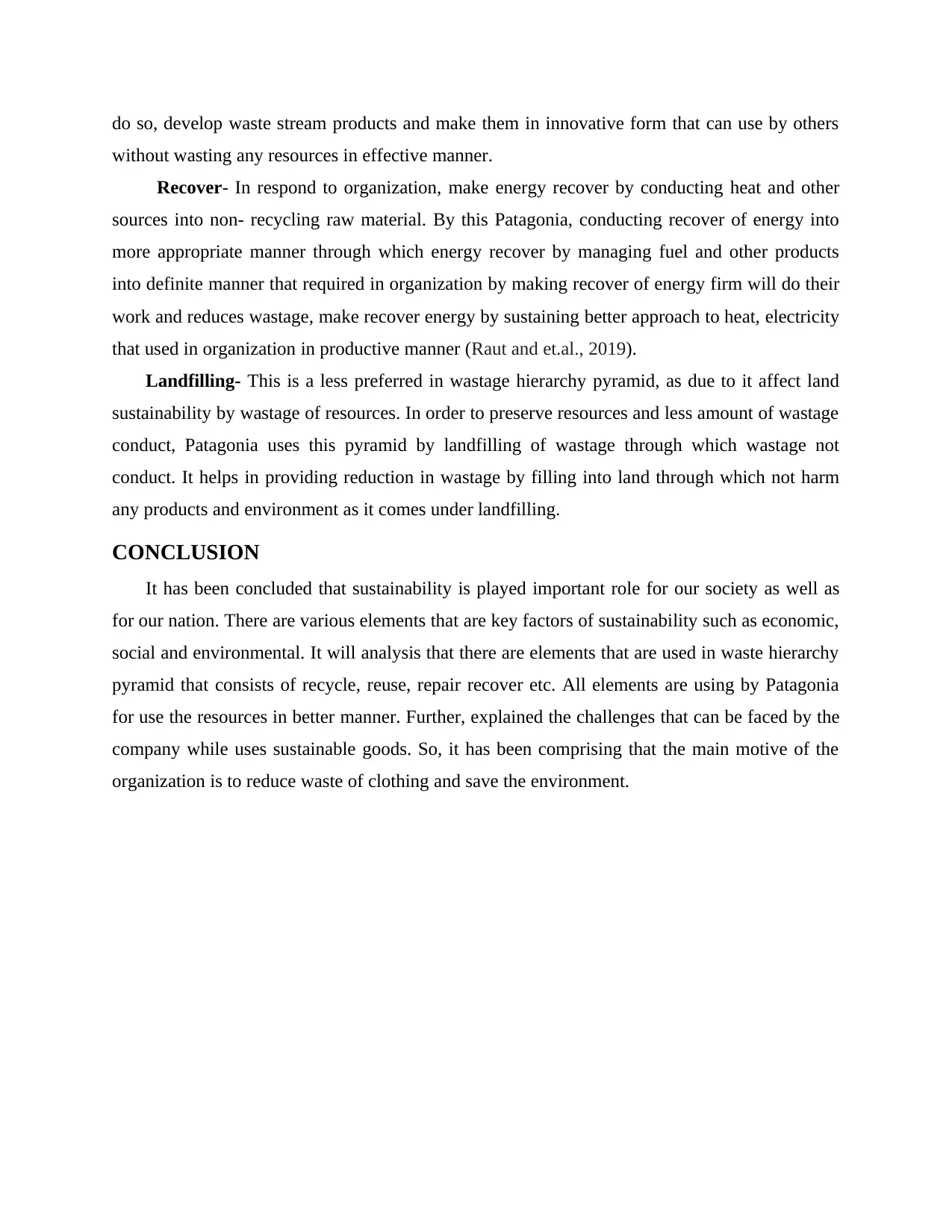
do so, develop waste stream products and make them in innovative form that can use by others
without wasting any resources in effective manner.
Recover- In respond to organization, make energy recover by conducting heat and other
sources into non- recycling raw material. By this Patagonia, conducting recover of energy into
more appropriate manner through which energy recover by managing fuel and other products
into definite manner that required in organization by making recover of energy firm will do their
work and reduces wastage, make recover energy by sustaining better approach to heat, electricity
that used in organization in productive manner (Raut and et.al., 2019).
Landfilling- This is a less preferred in wastage hierarchy pyramid, as due to it affect land
sustainability by wastage of resources. In order to preserve resources and less amount of wastage
conduct, Patagonia uses this pyramid by landfilling of wastage through which wastage not
conduct. It helps in providing reduction in wastage by filling into land through which not harm
any products and environment as it comes under landfilling.
CONCLUSION
It has been concluded that sustainability is played important role for our society as well as
for our nation. There are various elements that are key factors of sustainability such as economic,
social and environmental. It will analysis that there are elements that are used in waste hierarchy
pyramid that consists of recycle, reuse, repair recover etc. All elements are using by Patagonia
for use the resources in better manner. Further, explained the challenges that can be faced by the
company while uses sustainable goods. So, it has been comprising that the main motive of the
organization is to reduce waste of clothing and save the environment.
without wasting any resources in effective manner.
Recover- In respond to organization, make energy recover by conducting heat and other
sources into non- recycling raw material. By this Patagonia, conducting recover of energy into
more appropriate manner through which energy recover by managing fuel and other products
into definite manner that required in organization by making recover of energy firm will do their
work and reduces wastage, make recover energy by sustaining better approach to heat, electricity
that used in organization in productive manner (Raut and et.al., 2019).
Landfilling- This is a less preferred in wastage hierarchy pyramid, as due to it affect land
sustainability by wastage of resources. In order to preserve resources and less amount of wastage
conduct, Patagonia uses this pyramid by landfilling of wastage through which wastage not
conduct. It helps in providing reduction in wastage by filling into land through which not harm
any products and environment as it comes under landfilling.
CONCLUSION
It has been concluded that sustainability is played important role for our society as well as
for our nation. There are various elements that are key factors of sustainability such as economic,
social and environmental. It will analysis that there are elements that are used in waste hierarchy
pyramid that consists of recycle, reuse, repair recover etc. All elements are using by Patagonia
for use the resources in better manner. Further, explained the challenges that can be faced by the
company while uses sustainable goods. So, it has been comprising that the main motive of the
organization is to reduce waste of clothing and save the environment.
⊘ This is a preview!⊘
Do you want full access?
Subscribe today to unlock all pages.

Trusted by 1+ million students worldwide
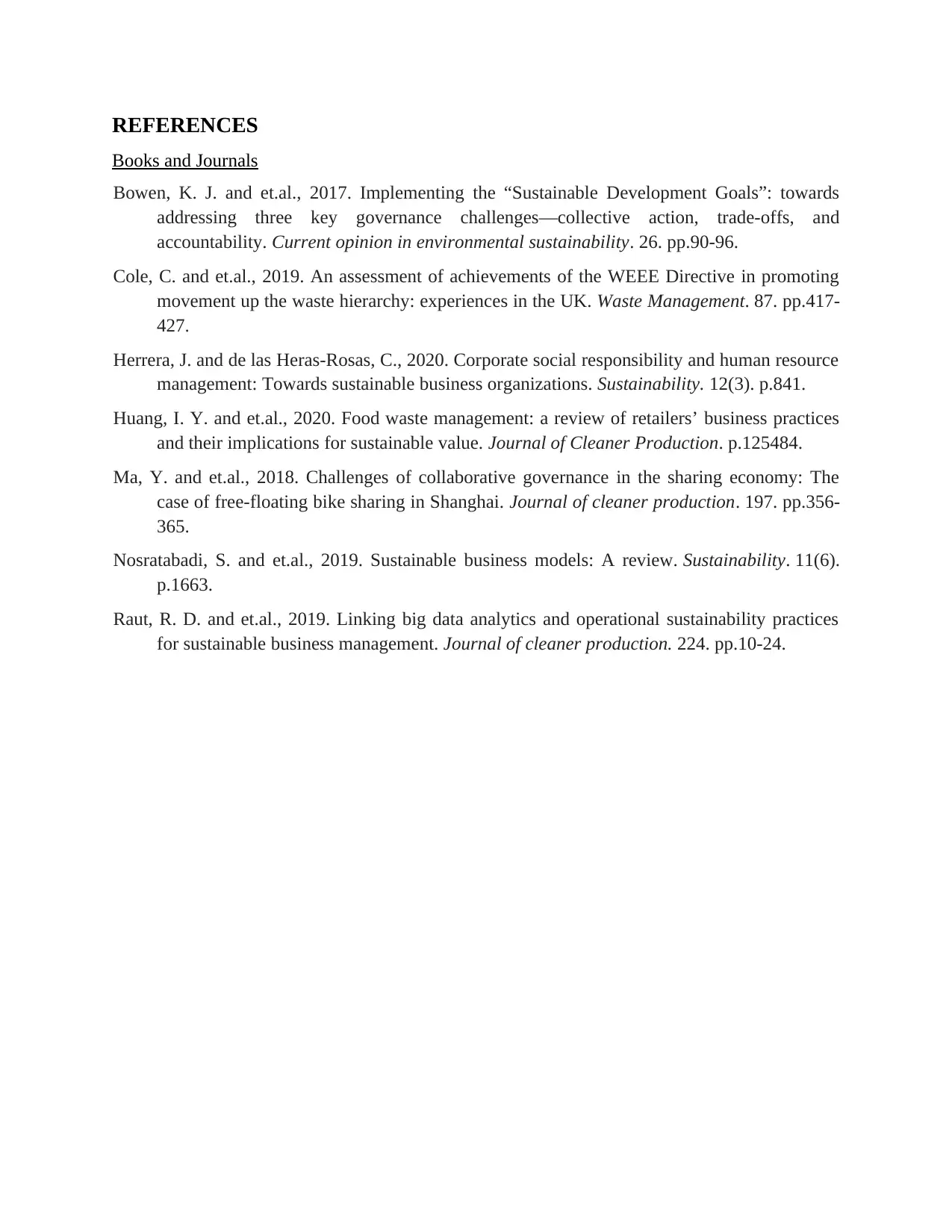
REFERENCES
Books and Journals
Bowen, K. J. and et.al., 2017. Implementing the “Sustainable Development Goals”: towards
addressing three key governance challenges—collective action, trade-offs, and
accountability. Current opinion in environmental sustainability. 26. pp.90-96.
Cole, C. and et.al., 2019. An assessment of achievements of the WEEE Directive in promoting
movement up the waste hierarchy: experiences in the UK. Waste Management. 87. pp.417-
427.
Herrera, J. and de las Heras-Rosas, C., 2020. Corporate social responsibility and human resource
management: Towards sustainable business organizations. Sustainability. 12(3). p.841.
Huang, I. Y. and et.al., 2020. Food waste management: a review of retailers’ business practices
and their implications for sustainable value. Journal of Cleaner Production. p.125484.
Ma, Y. and et.al., 2018. Challenges of collaborative governance in the sharing economy: The
case of free-floating bike sharing in Shanghai. Journal of cleaner production. 197. pp.356-
365.
Nosratabadi, S. and et.al., 2019. Sustainable business models: A review. Sustainability. 11(6).
p.1663.
Raut, R. D. and et.al., 2019. Linking big data analytics and operational sustainability practices
for sustainable business management. Journal of cleaner production. 224. pp.10-24.
Books and Journals
Bowen, K. J. and et.al., 2017. Implementing the “Sustainable Development Goals”: towards
addressing three key governance challenges—collective action, trade-offs, and
accountability. Current opinion in environmental sustainability. 26. pp.90-96.
Cole, C. and et.al., 2019. An assessment of achievements of the WEEE Directive in promoting
movement up the waste hierarchy: experiences in the UK. Waste Management. 87. pp.417-
427.
Herrera, J. and de las Heras-Rosas, C., 2020. Corporate social responsibility and human resource
management: Towards sustainable business organizations. Sustainability. 12(3). p.841.
Huang, I. Y. and et.al., 2020. Food waste management: a review of retailers’ business practices
and their implications for sustainable value. Journal of Cleaner Production. p.125484.
Ma, Y. and et.al., 2018. Challenges of collaborative governance in the sharing economy: The
case of free-floating bike sharing in Shanghai. Journal of cleaner production. 197. pp.356-
365.
Nosratabadi, S. and et.al., 2019. Sustainable business models: A review. Sustainability. 11(6).
p.1663.
Raut, R. D. and et.al., 2019. Linking big data analytics and operational sustainability practices
for sustainable business management. Journal of cleaner production. 224. pp.10-24.
1 out of 7
Related Documents
Your All-in-One AI-Powered Toolkit for Academic Success.
+13062052269
info@desklib.com
Available 24*7 on WhatsApp / Email
![[object Object]](/_next/static/media/star-bottom.7253800d.svg)
Unlock your academic potential
Copyright © 2020–2025 A2Z Services. All Rights Reserved. Developed and managed by ZUCOL.





